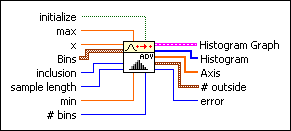 |
initialize, when TRUE, initializes the internal state of the VI.
|
 |
max specifies the maximum value to include in the histogram. LabVIEW ignores this control if the Bins input array is not empty.
|
 |
x is an input data point.
|
 |
Bins specifies the boundaries of each bin of the histogram. The input Bins is an array of clusters where each cluster defines the range of values for a bin.
 |
lower specifies the lower boundaries of the bin.
|
 |
upper specifies the upper boundaries of the bin.
|
 |
inclusion specifies how to treat the boundaries of each bin. If no bin specifications are provided in the input Bins, the inputs max, min, # bins, and inclusion are used to specify a set of uniformly spaced bins.
| 0 | Lower—Lower boundary is part of the bin but not the upper boundary. | | 1 | Upper—Upper boundary is part of the bin but not the lower boundary. | | 2 | Both—Both boundaries are part of the bin. | | 3 | Neither—Excludes both boundaries from the bin. |
|
|
 |
inclusion specifies how to handle the boundaries of each bin. If array Bins is not empty, LabVIEW ignores the max, min, # bins, and inclusion inputs.
| 0 | lower—Includes the lower boundary. | | 1 | upper—Includes the upper boundary. |
|
 |
sample length is the length of each set of incoming data. The VI processes each set of data. The default is 100. sample length must be greater than zero.
|
 |
min specifies the minimum value to include in the histogram. LabVIEW ignores this control if the Bins input array is not empty.
|
 |
# bins specifies the number of bins in the histogram. # bins is ignored if the Bins input array is not empty. The default behavior is to determine the number of bins according to Sturges' Rule, number of bins = 1 + 3.3log(size of(X)).
|
 |
Histogram Graph displays the bar graph of the histogram of the input sequence x. The y-axis is the histogram count, and the x-axis is the histogram center values of the intervals (bins) of the histogram.
|
 |
Histogram specifies the resulting histogram.
|
 |
Axis specifies the center values for each bin of Histogram. The centers of each bin are set according to the following equation and returned in the output array Axis.
center[i] = (lower + upper)/2,
where lower is the lower boundary of bin i, and upper is the upper boundary of bin i.
|
 |
# outside contains information about points not falling in any bin upon successful execution of the VI.  | Note The elements above and below have meaning only if you specify Bins such that Bins[0].upper  Bins[1].lower < Bins[1].upper, …– < Bins[k – 1].lower, and < Bins[k – 1].upper, where k is the number of elements in Bins. Bins[1].lower < Bins[1].upper, …– < Bins[k – 1].lower, and < Bins[k – 1].upper, where k is the number of elements in Bins. |
 |
total contains the total number of values in the set of input data points specified by sample length not falling in any bin upon successful execution.
|
 |
above represents the number of values in the set of input data points specified by sample length above the last bin on the upper boundary. The last bin on the upper boundary is Bins[size of(Bins) – 1].upper.
|
 |
below represents the number of values in the set of input data points specified by sample length below the first bin on the lower boundary. The first bin on the lower boundary is Bins[0].lower.
|
|
 |
error returns any error or warning from the VI. You can wire error to the Error Cluster From Error Code VI to convert the error code or warning into an error cluster.
|


 Add to the block diagram
Add to the block diagram Find on the palette
Find on the palette








 Bins[1].lower < Bins[1].upper, …– < Bins[k – 1].lower, and < Bins[k – 1].upper, where k is the number of elements in Bins.
Bins[1].lower < Bins[1].upper, …– < Bins[k – 1].lower, and < Bins[k – 1].upper, where k is the number of elements in Bins.